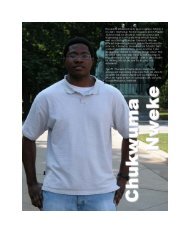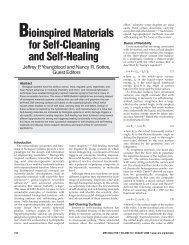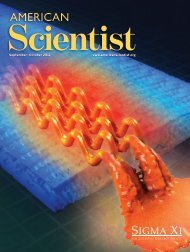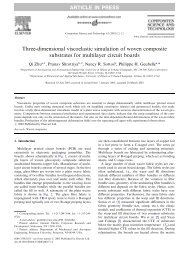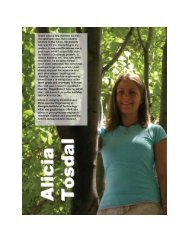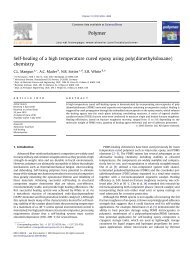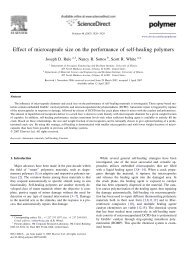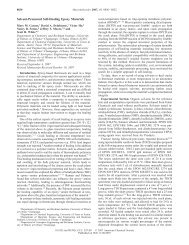Micro- and Nanoscale Deformation Measurement of Surface and ...
Micro- and Nanoscale Deformation Measurement of Surface and ...
Micro- and Nanoscale Deformation Measurement of Surface and ...
Create successful ePaper yourself
Turn your PDF publications into a flip-book with our unique Google optimized e-Paper software.
54 Exp Mech (2007) 47: 51–62<br />
Fig. 3 Schematic representation<br />
<strong>of</strong> (a) surface patterned,<br />
<strong>and</strong> (b) internally patterned<br />
samples prepared for digital<br />
image correlation<br />
<strong>Micro</strong>scale Airbrush DIC Pattern<br />
<strong>Surface</strong> pattern<br />
Following the method outlined in Patel, [13] speckle<br />
patterns suitable for DIC at image resolutions ranging<br />
from 3 to 10 mm/pixel were applied to sheets <strong>of</strong> a<br />
polyethylene–carbon monoxide (ECO) copolymer<br />
(ITW-HiCone, Inc.) using an Iwata Custom <strong>Micro</strong>n B<br />
airbrush. The nozzle diameter <strong>of</strong> this airbrush is 0.18<br />
mm which allows for greater paint diffusion resulting<br />
in smaller paint droplets (speckles) than those in<br />
Abanto-Bueno <strong>and</strong> Lambros [9, 11]. In addition, its<br />
gravity-feed system when coupled with a lighter weight<br />
drawing ink provided excellent consistency. Air was<br />
provided by a constant 100 psi pressure regulated<br />
compressed air system. When viewed under a microscope<br />
as shown in Fig. 1(b), the new pattern produces<br />
an image with similar characteristics to images previously<br />
known to have worked with DIC.<br />
Internal pattern<br />
For internal measurements, a transparent silicone<br />
rubber (GE Silicones, RTV-615) was chosen to enable<br />
optical imaging through the thickness <strong>of</strong> the sample.<br />
Specimens were prepared through a two step process.<br />
Initially, one polymer layer was cast into a multipart<br />
mold to a thickness <strong>of</strong> approximately 1.5 mm <strong>and</strong><br />
allowed to cure partially at room temperature for 24 h.<br />
While the exposed surface was still tacky because <strong>of</strong><br />
partial curing, a speckle pattern was sprayed on it<br />
using the method described above. After allowing the<br />
ink to dry for a few minutes, a second layer <strong>of</strong> silicone<br />
rubber, also 1.5 mm thick, was poured onto the first.<br />
The entire casting was then left for a few days to cure<br />
completely, after which time the specimens were<br />
removed from the mold <strong>and</strong> cut to final dimensions.<br />
The resulting internal speckle pattern was similar to<br />
the surface one shown in Fig. 1(b).<br />
A second set <strong>of</strong> microscale airbrush patterned<br />
samples were made in a similar manner, with the<br />
additional step <strong>of</strong> adding a dilute concentration <strong>of</strong><br />
silica glass microspheres (with radii r ¼ 70 80 mm)<br />
on top <strong>of</strong> the patterned bottom layer. After deposition<br />
<strong>of</strong> the top layer, the resulting specimen had internally<br />
embedded spheres with a patterned plane located just<br />
below it at z=jr (for z=0 at the sphere midplane). The<br />
patterned layer <strong>and</strong> embedded microspheres were<br />
situated the same as with the other samples, halfway<br />
through the sample thickness [Fig. 3(b)]. Polydimethylsiloxane<br />
(PDMS) was substituted as the matrix<br />
material in this case for meaningful comparisons with<br />
nanoparticle patterned samples.<br />
Table 1 Sample material, preparation details, <strong>and</strong> imaging conditions for each <strong>of</strong> the patterning methods tested<br />
Patterning method Material Sample preparation Imaged resolution<br />
Airbrushed, <strong>Surface</strong> ECO as delivered, fully cured 102m/pixel<br />
Airbrushed, Internal<br />
Silicone Rubber,<br />
first layer: 24 h at 30-C<br />
3.02m/pixel<br />
GE Silicones<br />
second layer: 48 h at 30-C<br />
Nanoparticle, <strong>Surface</strong> PDMS 48 hours at 30- 134 nm/pixel<br />
Nanoparticle, Internal PDMS first layer–48 hours at 30-C;<br />
UV, oxygen plasma treated;<br />
second layer–48 hours at 30-C<br />
213 nm/pixel<br />
SEM





